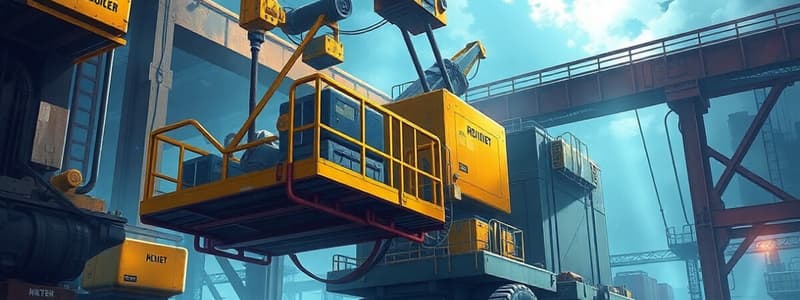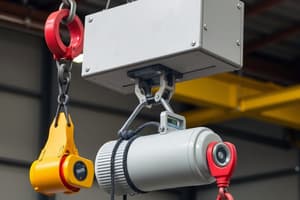Podcast
Questions and Answers
What is the primary alloying component of bronze?
What is the primary alloying component of bronze?
- Iron
- Manganese
- Nickel
- Tin (correct)
Which material is specifically mentioned as having good mechanical properties and excellent corrosion resistance?
Which material is specifically mentioned as having good mechanical properties and excellent corrosion resistance?
- Steel
- Bronze
- Monel Metal (correct)
- Aluminium
What percentage of chromium is required to classify a steel as stainless steel?
What percentage of chromium is required to classify a steel as stainless steel?
- 12% (correct)
- 10%
- 20%
- 15%
Why is aluminium favored in lifting equipment?
Why is aluminium favored in lifting equipment?
How is the breaking strength of chain grades expressed?
How is the breaking strength of chain grades expressed?
What is the main limitation of brass in lifting applications?
What is the main limitation of brass in lifting applications?
Which material is often utilized for creating lightweight mobile lifting frames?
Which material is often utilized for creating lightweight mobile lifting frames?
Which alloy is considered where steel gear cannot be used due to acidic conditions?
Which alloy is considered where steel gear cannot be used due to acidic conditions?
What does the term 'Minimum Breaking Load' refer to?
What does the term 'Minimum Breaking Load' refer to?
Which of these accurately describes 'Multipurpose Equipment'?
Which of these accurately describes 'Multipurpose Equipment'?
What is the 'Rated Capacity' of lifting equipment?
What is the 'Rated Capacity' of lifting equipment?
What does a 'Proof or Test Load' typically represent?
What does a 'Proof or Test Load' typically represent?
Which statement correctly defines 'Single Purpose Equipment'?
Which statement correctly defines 'Single Purpose Equipment'?
What is the primary role of an 'Operative'?
What is the primary role of an 'Operative'?
What information does a 'Report of Test' provide?
What information does a 'Report of Test' provide?
In which case is it necessary to perform a proof load test?
In which case is it necessary to perform a proof load test?
What is the net result of risk in a workplace environment defined as?
What is the net result of risk in a workplace environment defined as?
What should employers ensure regarding employee safety?
What should employers ensure regarding employee safety?
In an industry where most tasks require reduced working load equipment, what should be done?
In an industry where most tasks require reduced working load equipment, what should be done?
What does risk assessment primarily aim to do?
What does risk assessment primarily aim to do?
What is a contributing factor to workplace accidents and ill-health?
What is a contributing factor to workplace accidents and ill-health?
Which of the following does NOT contribute to the net result of risk?
Which of the following does NOT contribute to the net result of risk?
When considering equipment in hazardous industries, what principle should be applied?
When considering equipment in hazardous industries, what principle should be applied?
What moral duty do employers have regarding workplace safety?
What moral duty do employers have regarding workplace safety?
What is tensile strength primarily concerned with?
What is tensile strength primarily concerned with?
Which characteristic best describes ductility?
Which characteristic best describes ductility?
Which of the following materials would likely be described as brittle?
Which of the following materials would likely be described as brittle?
What does toughness measure in a material?
What does toughness measure in a material?
How does malleability differ from ductility?
How does malleability differ from ductility?
Which property describes a material's ability to retain its new dimensions after the removal of stress?
Which property describes a material's ability to retain its new dimensions after the removal of stress?
What occurs during corrosion?
What occurs during corrosion?
Which of the following is true about hardness in materials?
Which of the following is true about hardness in materials?
When might it be necessary to reduce the SWL of equipment?
When might it be necessary to reduce the SWL of equipment?
Who is responsible for declaring the need to reduce the SWL when ordering equipment?
Who is responsible for declaring the need to reduce the SWL when ordering equipment?
What should happen in the absence of a declaration regarding SWL?
What should happen in the absence of a declaration regarding SWL?
Which of the following conditions is classified as a hazardous duty?
Which of the following conditions is classified as a hazardous duty?
What is one key responsibility of the user if the equipment's SWL is not properly declared?
What is one key responsibility of the user if the equipment's SWL is not properly declared?
For permanently fixed installations, what can be done to indicate the reduced SWL?
For permanently fixed installations, what can be done to indicate the reduced SWL?
How should portable equipment indicate its reduced SWL?
How should portable equipment indicate its reduced SWL?
Why is it important to prevent normally rated equipment from being used to its full capacity?
Why is it important to prevent normally rated equipment from being used to its full capacity?
What does the acronym SWL stand for in the context of lifting equipment?
What does the acronym SWL stand for in the context of lifting equipment?
What is the purpose of a proof load test in relation to lifting accessories?
What is the purpose of a proof load test in relation to lifting accessories?
Which term is often used interchangeably with 'safe working load' in specific geographical regions?
Which term is often used interchangeably with 'safe working load' in specific geographical regions?
What does Working Load Limit (WLL) refer to in lifting equipment?
What does Working Load Limit (WLL) refer to in lifting equipment?
How does the Working Load Limit (WLL) differ from Safe Working Load (SWL)?
How does the Working Load Limit (WLL) differ from Safe Working Load (SWL)?
Which of the following statements best describes the purpose of the appendix in a thorough examination?
Which of the following statements best describes the purpose of the appendix in a thorough examination?
What common misconception exists between SWL, WLL, and rated capacity?
What common misconception exists between SWL, WLL, and rated capacity?
Who is responsible for assessing the Safe Working Load (SWL) of lifting equipment?
Who is responsible for assessing the Safe Working Load (SWL) of lifting equipment?
Flashcards
Rated Capacity
Rated Capacity
The maximum weight a lifting device can handle in any configuration.
Proof or Test Load
Proof or Test Load
A load applied to test the strength of equipment.
Single Purpose Equipment
Single Purpose Equipment
Equipment designed for very specific tasks and loads.
Multipurpose Equipment
Multipurpose Equipment
Signup and view all the flashcards
Minimum Breaking Load
Minimum Breaking Load
Signup and view all the flashcards
Operative
Operative
Signup and view all the flashcards
Report of Test
Report of Test
Signup and view all the flashcards
Single Purpose Equipment
Single Purpose Equipment
Signup and view all the flashcards
Risk
Risk
Signup and view all the flashcards
Risk Assessment
Risk Assessment
Signup and view all the flashcards
Risk Control
Risk Control
Signup and view all the flashcards
Probability
Probability
Signup and view all the flashcards
Consequences
Consequences
Signup and view all the flashcards
Safe Working Load (SWL)
Safe Working Load (SWL)
Signup and view all the flashcards
Working Load Limit (WLL)
Working Load Limit (WLL)
Signup and view all the flashcards
Proof Load Test
Proof Load Test
Signup and view all the flashcards
Thorough Examination
Thorough Examination
Signup and view all the flashcards
Test Report
Test Report
Signup and view all the flashcards
Test Report
Test Report
Signup and view all the flashcards
Test Report
Test Report
Signup and view all the flashcards
Test Report
Test Report
Signup and view all the flashcards
Hazardous Duties
Hazardous Duties
Signup and view all the flashcards
User Declaration
User Declaration
Signup and view all the flashcards
Key Considerations
Key Considerations
Signup and view all the flashcards
Marking for Reduced SWL
Marking for Reduced SWL
Signup and view all the flashcards
Correct SWL Attribution
Correct SWL Attribution
Signup and view all the flashcards
User Responsibility for SWL
User Responsibility for SWL
Signup and view all the flashcards
Written Instructions for Reduced SWL
Written Instructions for Reduced SWL
Signup and view all the flashcards
Strength
Strength
Signup and view all the flashcards
Ductility
Ductility
Signup and view all the flashcards
Malleability
Malleability
Signup and view all the flashcards
Brittleness
Brittleness
Signup and view all the flashcards
Elasticity
Elasticity
Signup and view all the flashcards
Plasticity
Plasticity
Signup and view all the flashcards
Toughness
Toughness
Signup and view all the flashcards
Hardness
Hardness
Signup and view all the flashcards
Bronze
Bronze
Signup and view all the flashcards
Monel Metal
Monel Metal
Signup and view all the flashcards
Aluminium
Aluminium
Signup and view all the flashcards
Stainless Steel
Stainless Steel
Signup and view all the flashcards
Chain Grade
Chain Grade
Signup and view all the flashcards
Minimum Breaking Load (MBL)
Minimum Breaking Load (MBL)
Signup and view all the flashcards
Study Notes
Industry Relevant Definitions
- Minimum Breaking (or Failure) Load: The specified load (mass or force) below which the equipment fails by fracture or distortion.
- Multipurpose Equipment: Designed to a standard specification for multiple lifting loads, not one specific application.
- Operative: Trained person operating the equipment.
- Rated Capacity: Maximum gross load the lifting appliance can lift in a given configuration.
- Proof or Test Load: A load (mass or force) applied to test the equipment by a Competent Person.
- Single Purpose Equipment: Dedicated to lifting a specific load in a precise manner and environment.
- Report of Test: A report issued by a competent person documenting test specifics and details. This isn't a legal document for use, except when supporting legal documents like EC Declaration of Conformity or Manufacturer's Certificate.
Verification
- Verification: A process ensuring lifting equipment meets legal requirements and specifications. This includes methods like proof load tests, sample break tests and more. It's a generic term to describe manufacturer or competent person methods to guarantee safe operation.
- New Equipment Verification: Depends on the standard the equipment is designed based on. Some equipment isn't suitable for proof load testing due to materials, while other components may be verified independently and just need assembly verification.
Report of Thorough Examination
- A report of a thorough examination (or periodic inspection) is issued by a Competent Person. It documents findings, defects, or statements of fitness for continued use.
- The report may contain details of any tests involved in the examination.
- Key Notes: The report must be kept as part of equipment records. In some cases, the test report will be an appendix.
Safe (Specific application) Working Load (SWL)
- Safe Working Load (SWL) or Specific Application Load (SWL): The maximum load determined by the Competent Person for a lifting item under specific service conditions.
- The SWL is generally equal to the working load limit (WLL) or rated capacity.
- The SWL may be less than the WLL in some circumstances regarding usage conditions.
Studying That Suits You
Use AI to generate personalized quizzes and flashcards to suit your learning preferences.




